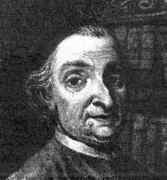Person: Riccati (2), Vincenzo

Vincenzo Riccati was an Italian Jesuit who worked on hyperbolic functions.
Mathematical Profile (Excerpt):
- Jacopo Riccati was of independent means and had a large estate at Castelfranco Veneto, a small town about 30 km north of Padua and about 40 km north west of Venice.
- Vincenzo's early education was at home and from the Jesuits.
- Riccati entered the Jesuit order on 20 December 1726 going to the Jesuit College in Piacenza in 1728 to teach literature.
- It was Gian Francesco Malfatti, who studied under Riccati in the early 1750s, who became the most famous mathematician from among his pupils but it is worth commenting briefly on some of the others who also made significant contributions.
- Virgilio Cavina (1731-1808) was taught by Riccati beginning in 1743 before he became a teacher in Brescia.
- Leopoldo Marco Antonio Caldani (1725-1813) studied under Riccati in Bologna but went on to take a medical degree in 1750.
- Pietro Giannini was a student of Riccati and he strongly influenced Giannini to publish his first book Opuscula Mathematica (1773).
- Vincenzo's favorite field of research is analysis, in particular setting out the analytical treatment of mechanical problems, conducted by solving differential equations, properly constructed.
- Vincenzo gave a collection of methods to solve certain specific types of differential equations in his memoir De usu motus tractorii in constructione Aequationum Differentialium Commentarius (1752).
- Vincenzo Riccati, somehow, put an end to this trend by showing that one could construct in a simple continuous way all transcendental curves from the differential equations that define them.
- However, the work of Vincenzo Riccati did not bring him fame and has virtually been forgotten.
- Vincenzo studied hyperbolic functions and used them to obtain solutions of cubic equations.
- Johann Heinrich Lambert is often cited as the first to introduce the hyperbolic functions but he did not do so until 1770 while Vincenzo Riccati's work (some joint with Girolamo Saladini (1731-1813)) was published between 1757 and 1767.
- Saladini, who was a brilliant student of Riccati's, was a co-author with Riccati of the two volume book Institutiones Analyticae (Vol 1, 1765; Vol 2, 1767) which contains the formulas for the addition and subtraction of hyperbolic functions as well as other, now standard, formulas analogous to those for the circular functions.
- Although both Newton and Leibniz had recognized that integration and derivation are inverse operations, they had defined the integral of a function as a second function from which the former function is derived; Riccati and Saladini, on the other hand, considered differentiation to be the division of a quantity into its elements and integration to be the addition of these elements and offered examples of direct integrations.
- Riccati and Saladini also worked on the 'rose curves' which had been introduced by Guido Grandi.
- Al-Haytham had a less than satisfactory solution to his own problem, Christiaan Huygens found a good solution which Vincenzo Riccati and Saladini simplified and improved.
- As we have noted, Riccati taught at Jesuit Colleges in Bologna but as the years went by the Jesuit Order came under attack from opponents within the Catholic Church.
- In 1773, shortly after he moved to Treviso, Vincenzo Riccati was offered the chair of mathematics at the University of Bologna and, around the same time, he was also offered the chair of mathematics at Pisa.
Born 11 January 1707, Castelfranco Veneto near Treviso (now Italy). Died 17 January 1775, Treviso (now Italy).
View full biography at MacTutor
Tags relevant for this person:
Origin Italy
Thank you to the contributors under CC BY-SA 4.0! 

- Github:
-

- non-Github:
- @J-J-O'Connor
- @E-F-Robertson
References
Adapted from other CC BY-SA 4.0 Sources:
- O’Connor, John J; Robertson, Edmund F: MacTutor History of Mathematics Archive
